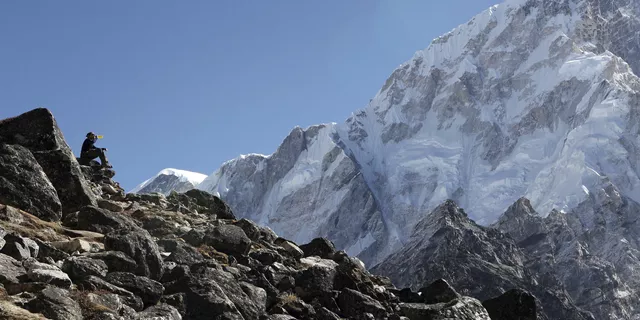
11 most dangerous hiking trails in the world
(ORDO NEWS) — Hiking is often derided by thrill-seekers as the “little brothers” of real adventures like mountain climbing and skiing.
However, as the experience of those who have managed to overcome the most dangerous hiking trails in the world shows, walking is not always easy.
To follow these well-known routes, you will need not only a significant amount of willpower.
These routes are dangerous, and only experienced and trained hikers can overcome them, that is, people who have all the necessary equipment, who have the ability to get out of various dangerous situations, as well as the willingness to face and survive the worst-case scenario.
Do you want to try walking the dizzying Lake District in England or the “world’s most dangerous trail” in China? Below we have compiled for you a completely exhaustive list of such routes.
Striding Edge, Lake District, England
Known for its changeable weather in the Lake District, even the most serene walk can be a real challenge.
But in this corner of England, Striding Edge – the cusp that leads to Helvellyn, the third highest peak in the Lake District National Park – stands apart.
Hikers can choose trails that run along the side of the ridge, but those who love the thrill can try to conquer the ridge itself.
On a clear day, there are stunning views all the way to Scotland.
This route is not for beginners or the faint of heart: hikers must be prepared to climb, have some climbing skills to get to the very top, and know how to behave if the sky suddenly becomes overcast.
Ice and snow make this a deadly route in winter, so you’ll need the proper preparation and the ability to turn back if necessary.
“Labyrinth”, Canyonlands, Utah, US
When it comes to the “Labyrinth”, the representatives of the National Park Service prefer to speak frankly.
They call hiking this route “very difficult”, warning of slippery rocks and steep drops.
This is the most remote part of Canyonlands, where visitors must first drive long dirt roads before they get into deep ravines where rockfalls and flash floods are not uncommon. In addition, it is very difficult to find drinking water there (so it is imperative to take a supply of water with you, which will last for many days).
Park rangers demand that all visitors tell them in detail about their routes and get in touch as often as possible. However, those who still dare to go there will see absolutely stunning, timeless landscapes and are unlikely to meet other people on their way.
Mount Huashan, China
The epic route to the South Peak of Mount Huashan, one of the five great mountains of China, is often called the most dangerous route in the world, and with good reason.
To reach the 2,150-meter peak, hikers must climb uneven steps and a series of ladders before they can hook onto a cable with slings and carabiners to follow the famous “plank path”.
The name of the trail fully corresponds to its appearance: these are ordinary wooden boards, bolted to the rock, on which you have to walk.
Although many tourists come there in sneakers and T-shirts, this is not a route that is worth conquering without preparation.
You need the right hiking boots, plenty of food and water, and a high level of fitness.
Giro del Sorapis, Italy
The Dolomites are home to several breathtaking “via ferrata” (literally “iron tracks”) – paths made of metal steps driven into the rock during World War I, when Italian and Austrian troops fought fierce battles on the limestone peaks of the region.
Nowadays, during the spring and summer months, tourists come here who want to experience the thrill of rock climbing, but are not ready for a fall from a great height.
The Giro del Sorapis is the biggest challenge of all. Hikers will need appropriate climbing equipment, a helmet, and ideally a guide who can show the way.
Grand traverse to Drakensberg, South Africa and Lesotho
Multi-day hikes give intrepid hikers the chance to test their skills to the limit, while changeable weather and the need to carry enough supplies with them turn out to be a real challenge.
The Grand Traverse Drakensberg is certainly one of those routes. The epic 230-kilometer route, which can take up to two weeks to complete, begins with a chain ladder climb to the Drakensberg Escarpment, then crosses the border into Lesotho and eventually returns to South Africa.
You can try to walk this long path alone, but hikers should remember that the trail itself is more of a direction, not a visible path at all. This means that anyone planning to go there will need all available route maps, GPS, and enough food and water.
Tourists are advised to come there in autumn or spring, avoiding difficult summer grass and harsh winter days.
Cascading saddle in New Zealand
Located in the heart of Mount Aspiring National Park on New Zealand’s South Island, the Cascade Saddle is one of the best mountain scenery in the world.
Due to a string of deaths at the start of this century, slippery cliffs and changeable weather conditions, the country’s Department of Conservation insists this route is “only for people with orienteering skills and extensive backcountry experience” and warns that if something goes wrong, you must immediately turn back.
This route takes about two days, and along the way you can camp or spend the night in mountain huts. On the way, you will have to climb steep slopes more than once, walk along bare stones and wade through thick grass.
The reward will be endless views of snow-capped peaks, including a view of the stunning Mount Aspiring, also called Tititea.
Kalalau Trail, Hawaii
The 35-kilometer Kalalau Trail along Kauai’s Na Pali Coast is not only the most dangerous trail in Hawaii, but also one of the deadliest in the entire United States.
This trail through the jungle leads to the coast, and the Pacific Ocean rages below.
You will need a special permit to go beyond Hanakapiai Beach into the Hanakoa Valley and camp either in the valley or on Kalalau Beach.
Although this place may seem completely idyllic, the three intersecting streams here can be deadly after heavy rain, when the water rises to extremely high levels.
This dizzying path along Crawler’s Ledge will turn into a real disaster for inexperienced tourists. It is only suitable for those who have the appropriate skills and training.
Huayna Picchu, Peru
Anyone who has seen a picture of the hugely popular Machu Picchu has probably caught a glimpse of Huayna Picchu as well. This is a high peak, which is located behind the famous lost city of the Incas. She can be seen in countless social media posts and postcards people send home from South America.
However, to get to this peak, you need to climb the so-called “stairs of death” – steps that are more than 500 years old and on the side of which there is a sheer cliff.
Even the most hardened hikers get dizzy and nauseous at some sections of this staircase, making this route not to be underestimated. While many go there unprepared, hiking boots and the help of a local guide are highly recommended. The path may seem extremely intimidating, but the view of the citadel below is really worth the three hours of climbing up.
Kokoda Trail, Papua New Guinea
The 96-kilometer Kokoda Trail runs from the capital city of Port Moresby to the village of Kokoda, crossing the Owen Stanley Range.
The journey through this isolated area takes up to two weeks due to daytime showers, turbulent streams, and a treacherously slippery path that is very difficult to navigate due to ankle-deep mud and tree roots.
Following the deaths of 13 Australians on their way to the trail in a light aircraft in 2009, local authorities have taken action to make it safer to access.
All hikers must obtain a permit and are required to enter the trail only with a licensed guide – which also allows local communities to profit from tourism. To prepare for hot days and humid nights in this remote corner of the world, organizers recommend training throughout the year.
While walking along this wild route, it is worth remembering that it became the scene of fierce battles between Japanese and allied Australian and Papuan forces during World War II.
Traverse Daikiretto, Japan
The northern Japanese Alps are home to some of the most breathtaking and challenging hiking in the country. And the Daiquiretto Traverse is definitely the route to try for hikers looking for a real adventure – as close as possible to technical climbing without lines.
This route is less than two miles long but can take several hours to complete and is best done on a longer guided hike up this beautiful ridge.
You will have to use chains and ladders to cross this traverse, after which you will reach a sharp ridge with drop-offs hundreds of meters down on both sides.
A high level of physical fitness and no fear of heights are required here. A helmet and gloves will make the transition easier, and it should be noted that traveling alone, especially in winter, is not recommended.
Mount Washington, New Hampshire, US
Mount Washington is known for having “the worst weather in the world” (at least according to the Mount Washington Observatory).
In January 2004, the temperature at its summit dropped to minus 44 degrees Celsius. In the same place, in 1934, a record was set for the highest wind speed – 372 kilometers per hour. This record was only broken in 1996 at Sharp Barrow, Australia.
All this suggests that hiking in these places requires serious preparation. Weather conditions can change at any moment, which means that you will need to bring winter gear with you even in the midst of summer.
Climbing is no joke, and hikers need to be in top shape to make it. Yes, it is possible to reach the summit by car or by the famous train, but anyone who is well prepared and willing to take on the challenge should put on good trekking boots, fill their backpacks and make the ascent on foot.
—
Online:
Contact us: [email protected]
Our Standards, Terms of Use: Standard Terms And Conditions.








